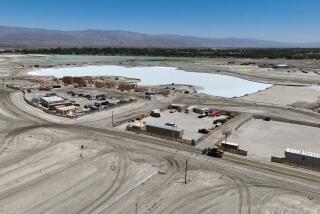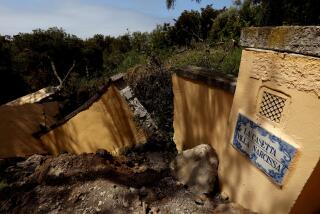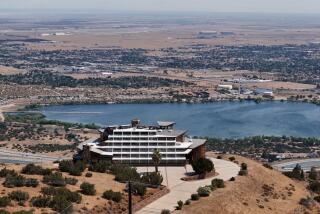Hamlet Bucks Trend; 2 Wells Point to Boom
- Share via
NEW CUYAMA, Calif. — While much of the rest of the country hunkers through these recession-like times and the state copes with its most severe drought in decades, a building boom is about to occur in this isolated hamlet in northern Santa Barbara County.
Residents of this former company town have worried about a growth-limiting water shortage for more than 30 years, but now things are looking up.
The reason for optimism is the successful drilling of two 1,000-foot-deep wells with the capacity of providing the town’s 800 residents a daily average of 1,000 gallons of water a minute.
As a result, the state Department of Health Services recently lifted a moratorium on construction of homes and other buildings in New Cuyama (pronounced qwee-ama). The restriction was imposed in 1958 because of a water shortage and the quality of water available.
“We have a total of 210 homes in town, all built between 1951 and 1958,” said U. S. Wilson, 58, manager of the Cuyama Community Service District. “We now have permission to erect 72 new houses with more permits expected later this year because of good quality water now available.”
Longtime resident Margaret Emfinger, manager of the town’s only grocery store, C & H Market, noted that while Southern California has been booming since the 1960s with new housing developments, shopping centers and industry, New Cuyama has been “stagnant.”
“New Cuyama residents have been waiting since 1958 for the moratorium to end, for the ability to build more homes in this town,” Emfinger said. “Now, at long last, like everywhere else in Southern California, our town will . . . experience growth.”
New Cuyama came into existence because Atlantic Richfield struck oil in 1948 in Cuyama Valley in the northeast corner of Santa Barbara County where Santa Barbara, San Luis Obispo, Ventura and Kern counties come together.
Arco, then known as Richfield Oil Co., built everything in the town, all 210 homes, the business buildings, the streets, the water and sewer system. It was a company town for the first several years until the three-bedroom, 1,200-square-foot homes were sold to employees.
Water was a problem from the beginning. Pure water was there all the time, but it is now known that the wells were never drilled deep enough to reach an ample and potable supply.
“There was never enough water, and it was never safe to drink,” explained Wilson, who worked for the oil company in New Cuyama from 1964 to 1975. “It was full of nitrates, iron, calcium, magnesium and other minerals. Richfield provided bottled and soft water to residents without charge because of the problem.”
Today, the town’s homes are privately owned and reselling from $30,000 to $95,000, depending upon improvements. About 40% of the townspeople are retired, and most are former Arco employees and spouses.
Arco no longer has a presence in town, but two small oil companies employ 28 residents. Others who live here work on farms or in Maricopa, Taft, Santa Maria--60 miles to the west--or in Bakersfield, 70 miles to the east.
Hazel Martin, 73, the town’s real estate broker for the past 35 years, has spent her time and effort mostly selling farmland and ranches in the valley and, now and then, reselling homes in town.
Now that the moratorium has been lifted, Martin hopes that a small industry will locate in New Cuyama and that it will bring in more new residents.
“We have had a half-dozen 10,000-foot-square industrial buildings and a 30,000-square-foot office building all formerly owned by Richfield Oil sitting empty since the early 1970s,” Martin said.
“This valley is in such a beautiful setting at an elevation of 2,200 feet nestled between two mountain ranges with ideal year-round climate,” she said. “But few people know we exist. We’re off the beaten path.”
More to Read
Sign up for Essential California
The most important California stories and recommendations in your inbox every morning.
You may occasionally receive promotional content from the Los Angeles Times.










